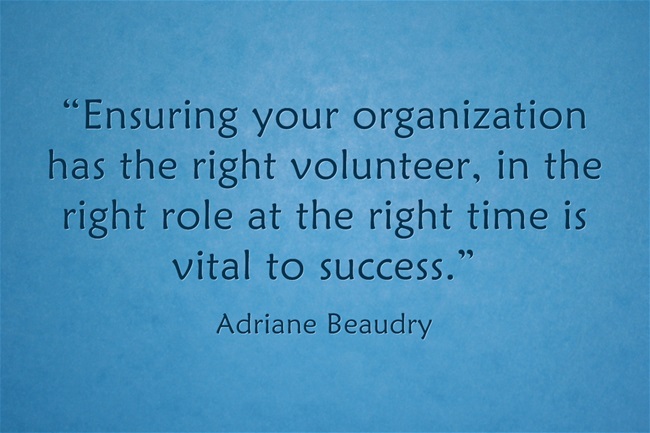How to effectively engage communications volunteers
If your organization’s communications team includes volunteers, it’s important to build a foundation for success through clear communication, structure, orientation, training and support. Communications volunteers may be responsible for developing or delivering your nonprofit’s messages and for representing your brand. Therefore, they must be meaningfully, carefully and effectively engaged.
To begin, assess what it is you need communications volunteers to do. Also, assess whether your organization has the capacity to effectively engage communications volunteers, including the time and skills required for project management, supervision, training, follow-up, recognition, etc. More bodies on board for the sake of more bodies does not automatically lead to better results – and if not carefully planned, can lead to a further drain on employee time and resources. However, managed effectively, communications volunteers can amplify your nonprofit’s voice and communications capacity.
Work with your volunteer development manager or coordinator and ask for their input and expertise if you’ve never managed volunteers before. Communications volunteers are no different from any others when it comes to the basic principles and practices of good volunteer management.
“Many agencies have a volunteer department; if so, recruitment and initial intake should be done through them,” says Adriane Beaudry, Past President, Professional Administrators of Volunteer Resources-Ontario, and Certified Volunteer Resources Manager. “If the agency already has the infrastructure in place, working together ensures all the proper tasks are completed for volunteer engagement.”
Determine need and capacity for communications volunteers
Determine whether your nonprofit needs communications volunteers and whether it has the capacity to deploy them effectively by answering the following questions:
- What communications roles can volunteers fill? What gaps in your skill set or time will they fill?
- Is there physical space for the volunteers to come into your office? Are they able to work virtually?
- Is the organization flexible to new ideas the volunteer may bring? Highly skilled professionals may bring a new way of doing things and new ideas such as focusing on photo journalism, digital storytelling, etc.
- What existing team members will support the volunteers? Are they open to working with them?
- Do these team members have volunteer management experience and skills or will they need support in this area?
Establish and articulate roles
Create a volunteer role description for each position you wish to fill. Outline what the roles and responsibilities will be, just as you would for an employee. Wherever possible, put a time frame around each role, making it project-based and outcome-based. This gives both you and your volunteer a framework around which to plan commitments and evaluations; you can always offer new or recurring roles if things are working out well. Try to think of communications volunteer roles as a means to enhance your capacity, not replace staff roles, since you want to build a consistent team to deliver communications on an ongoing basis.
Recruit strategically
Think strategically about how you will recruit communications volunteers. In planning your roles, you thought about the work that you need done; think also about who can best fill this need, where you can find or reach them and what will motivate them to volunteer. In addition to your organization’s usual volunteer recruitment channels, tap into established community networks such as schools, professional associations, your own network, retired persons groups, etc., depending on the level and responsibilities required of the role. Your local volunteer centre can help you connect to new markets.
Screen and evaluate
Screen and evaluate volunteer candidates for a good fit, just as you would for a staff role. Put in the time now to ensure a smooth and effective working relationship.
- Determine the appropriate screening process: ask candidates to complete an application form and submit a resume, portfolio or writing sample (depending on the role).
- Interview candidates and check references.
- Evaluate the fit of each candidate based on their:
- Skills and expertise
- Motivations for wanting to volunteer
- Time (both number of hours and time of day) they have available and commitment they are able to make.
- Balance this with the needs of your organization to see how well they fit
Manage expectations on both sides – discuss the scope of the role you’re offering as well as the support and professional development you’re able to provide. Get a clear understanding of your candidate’s ability to deliver in terms of both time and skills. If there isn’t a fit, refer them to your volunteer engagement coordinator, volunteer centre or another organization which may be a better fit.
Provide orientation and training
Understand that to deliver or advise on communications, volunteers should have a clear and in depth knowledge of your organization. Provide a volunteer orientation to all communications volunteers – even those who have previously volunteered for your organization in other capacities. Orientation can take many forms in order to be as convenient as possible for both you and the volunteers. Translate in-person training into other formats such as webinars, training videos or SlideShare presentations that can be accessed at home.
Be sure to give an overview of the policies and procedures as well as dos and don’ts of the agency. Your organization’s volunteer engagement professional should have tools and resources to help with this.
Provide communications volunteers with your nonprofit’s branding guidelines, including visual identity and messaging style guide along with any other guidelines or policies that will support them in their specific roles (e.g. social media policies, blog or newsletter editorial guidelines, editorial calendars, etc.)
In addition to general orientation, be prepared to provide communications volunteers with role-specific training. For volunteers looking to build their communications skills, support them with resources on nonprofit communications. Here are a few recommendations:
Books
- Brandraising: How Nonprofits Raise Visibility and Money Through Smart Communications
- The Nonprofit Marketing Guide: High-Impact, Low-Cost Ways to Build Support for Your Good Cause
Blogs
- Nonprofit MarCommunity blog!
- Nonprofit Marketing Guide
- Getting Attention
- Nonprofit Technology Network
Offer ongoing experiences and immersion
Keep communications volunteers engaged in the work of your organization in order to provide them with an ongoing and continuously developing understanding of what you do. Welcome and invite volunteers to attend any local programs or fundraising events; let them see your organization in action. Occasionally offer communications volunteers opportunities to volunteer in other capacities – they might have the time and the interest in feeling more of a part of the work that you do.
Ask volunteers permission to be subscribed to your nonprofit’s newsletter to help keep them up to date. If appropriate and you have one, send communications volunteers your internal or volunteer newsletter or access to appropriate internal blogs. And engage with volunteers on social media on an ongoing basis.
“Ensuring your organization has the right volunteer, in the right role at the right time is vital to success,” says Beaudry. “Volunteer engagement is a two way street: balance your organization’s needs with the needs of the volunteer and you’re off to a great start!”
Related resources
- The Screening Handbook prepared by Volunteer Canada
- Designing Volunteer Roles and Position Descriptions Toolkit by Volunteering Australia
- Tips for posting effective opportunities from AARP
What other tips or advice can you share on effectively engaging communications volunteers?



 PRINT
PRINT
